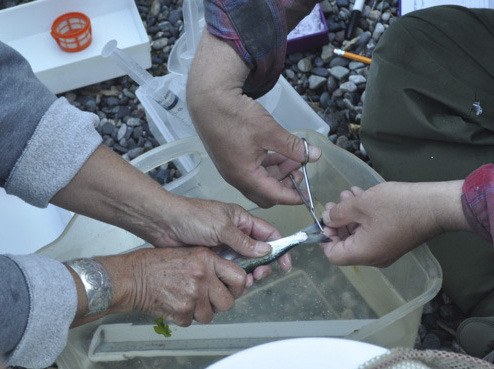A warming trend in the Pacific Ocean contributed to exceptionally high summer water temperatures in the San Juan Islands and significant changes in the behavior of out-migrating Chinook salmon and their fishy prey, according to the sixth annual monitoring report of Kwiaht’s marine food web study team.
Climate impacts will be the focus of this winter’s SalmonAtion event on Saturday January 17 at Woodmen Hall. As always, the annual research slideshow presentation will be accompanied by food, wine, music, art and an opportunity to celebrate Lopez Island’s intrepid marine-science volunteers. Gretchen Wing and Lance Brittain, Vita’s, and Lopez Island Vineyards help make SalmonAtion a unique fusion of science, education, and mid-winter community gathering.
“After five years of pretty consistent interactions between juvenile salmon and the herring and sandlance that bring them to the islands every summer,” says Kwiaht director Russel Barsh, “things turned upside down in 2014.” Local herring thrived but few salmon showed up to eat them. Herring also remained in the islands’ waters later into fall, a boon for seabirds. Barsh speculates that warmer waters helped herring eat better and their eggs develop faster, but discouraged young salmon from leaving mainland estuaries.
“We also observed a significant increase this year in VHS, a disease of herring as well as other fish that is more virulent at warmer temperatures,” Barsh says, suggesting that 2014 may have been a preview of changing ecological conditions in the near future.
Kwiahr’s work on juvenile Chinook in the islands drew the attention of the Salish Sea Marine Survival Project, a recently formed consortium that includes NOAA, Seattle-King County, many of the Tribes, and the University of Washington, and now, Kwiaht as well. Last year, juvenile Puget Sound Chinook were sampled repeatedly as they migrated from river deltas through the Sound to Lopez Island. “It looks like Chinook switch from eating invertebrates to eating fish when they get to the islands,” Barsh says. “It’s not just a matter of size, but also what’s available.”
This summer, Kwiaht teams also began collecting zooplankton near sites where salmon are feasting on sandlance and herring, to “see what feeds the fish that feeds the Chinook”. Samples are analyzed at the University of Washington in Seattle.
You can learn more about the changing ecology of salmon and forage fish in the islands at SalmonAtion, Woodmen Hall, January 17 beginning at 5:30 pm. Admission is free, and young people interested in the environment are especially encouraged to attend. Write to kwiaht@gmail.com for more information.





